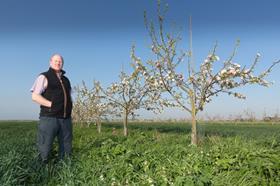
Watching your livelihood literally blow away in the wind is not something that many have experienced, but that is exactly what was happening to organic grower Stephen Briggs before he adopted a natural solution to the problem.
Briggs, who grew a number of different crops before switching to lettuce, is one of around 40 farmers in the UK using a technique called agroforestry, whereby trees – in Briggs’ case apple trees – are planted in rows right up the middle of a field. The aim is to improve efficiency and productivity on the farm by tackling soil erosion, improving soil quality, reducing runoff, or providing a shelterbelt for produce – as well providing an additional crop for the grower. Although the system is still unknown to many, there’s a growing awareness and interest in it, Briggs says, with the UK’s first agroforestry conference in June heavily oversubscribed.
“We started farming in 2007 and we soon realised that on the Fenland soils, wind erosion was a major issue,” recalls the grower. “A couple of decades ago I spend some time working for the Department for International Development (DFID) and the World Bank in Africa and I wondered whether it would be possible to introduce an agroforestry system like the ones I saw in Kenya and Uganda.”
Agroforestry seemed like an ideal solution to Briggs for several reasons. Firstly, the trees would act as windbreaks, helping to slow the wind and reduce soil erosion; secondly, it would introduce a resilient mix of perennials and annuals; and thirdly, it would draw on the concept of 3D farming, according to which there is lots of space above and below ground level that farmers can access.
The real genius of the system, however, is that it makes environmental protection profitable, by ensuring that the trees planted deliver an economic return. Briggs estimates that his 4,500 apple trees will give him “full payback” within five to ten years, and that’s at wholesale values – “if I can treble the value through direct retailing, that payback becomes much quicker”, he adds as he looks forward to opening a farm shop next month.
Briggs boosts his profits further by processing the apples for juice, but the trees only occupy eight per cent of his land, meaning that a bad apple harvest only has a limited impact on his overall returns. “I haven’t got all my eggs in one basket,” he says.
Aside from this, agroforestry brings numerous environmental benefits, boosting biodiversity and creating what Briggs calls “turbo-charged beetle banks”. As an organic operation, natural predators are key to pest and disease management on Briggs’ farm, and although pesticides aren’t used, the grower says he doesn’t struggle with pest or disease problems. The downside is that there are more weeds “because we’ve created lots of margin”, but the other impact of having “more edge” has been a dramatic rise in bird numbers. “The most biodiverse areas on a farm are the edge habitats,” he explains. “Our owl numbers have gone up 400 per cent and that’s because there’s lots for them to eat.”
Unsurprisingly, Briggs’ farm has attracted the attention of PhD and MSc students, who have found a much greater abundance of biodiversity in the areas of his farm with agroforestry than in those without it. But it’s the economic benefit of the system that Briggs thinks will attract growers to adopt it. “Most farmers have trees or woody perennials, but they don’t place any value in them other than to create biodiversity,” he says. “If you can have an economic output from them, it’s a different conversation. They’re an untapped resource.”
The main thing holding growers back from getting involved at the moment is funding. As it stands, agroforestry is fundable within the Common Agricultural Policy under Pillar II, but that measure has to be applied at a domestic level. Scotland, Northern Ireland and Wales have done this, but England, to date, has chosen not to make funding available to farmers. This is likely to change post-Brexit, Briggs believes, with Michael Gove “very attuned” to the issue of soil degradation. But before this can happen, the government needs to stop differentiating between agricultural land and forestland.
“CAP has made it very difficult to have agroforestry because it’s separated trees from cropping,” Briggs explains. “Until 2012 if you had more than 50 trees per hectare on your land, that land would cease to be agricultural and become forestry. I was one of three people who stood up in the parliament in Brussels and argued for change and we got that shifted to 100 trees per hectare. We hope that under our own domestic policy there wouldn’t be any limit at all.”
This week, Briggs, who has become something of an agroforestry ambassador, met with ministers to discuss how the technique could form part of Britain’s future agricultural policy. With better government support, he believes the system could really take off.



